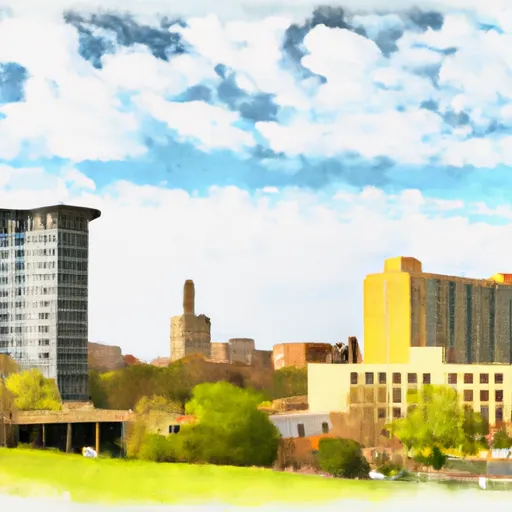-
 Snoflo Premium
Snoflo Premium
Get unlimited access to all our content
With no Ad interruptions! - Start Your Free Trial Login with existing account
Urbana
Eden Index
Climate
8.1
•
Recreation
2.5
•
Community
2.9
•
Safeguard
4.8/10

Urbana, Illinois is a vibrant city located in central Illinois and is known for its rich cultural and educational offerings. The climate in Urbana is characterized by hot summers and cold winters. Summers are typically warm with temperatures ranging from the 80s to 90s Fahrenheit, while winters can be chilly with temperatures often dropping below freezing.
Urbana is not situated near any major water bodies, but it benefits from the abundance of rivers and streams in the surrounding area. The Boneyard Creek, which runs through the city, is an important hydrological feature. It has undergone restoration efforts to improve water quality and enhance habitat for aquatic life.
Outdoor recreation opportunities in Urbana are plentiful and varied. Meadowbrook Park, spanning over 130 acres, offers walking and biking trails, prairie gardens, and a picturesque lake. Crystal Lake Park is another popular destination, providing opportunities for fishing, picnicking, and paddle boating. Additionally, the University of Illinois Arboretum offers a serene and scenic environment for walks and nature exploration.
Overall, Urbana, Illinois offers a diverse range of outdoor activities, beautiful natural spaces, and a moderate climate, making it an attractive destination for nature enthusiasts and outdoor lovers.
What is the Eden Index?
The Snoflo Eden Index serves as a comprehensive rating system for regions, evaluating their desirability through a holistic assessment of climate health, outdoor recreation opportunities, and natural disaster risk, acknowledging the profound impact of these factors on livability and well-being.
Climate Health Indicator (CHI): 8.1
Urbana receives approximately
1024mm of rain per year,
with humidity levels near 84%
and air temperatures averaging around
11°C.
Urbana has a plant hardyness factor of
5, meaning
plants and agriculture in this region thrive during a short period during spring and early summer. Most
plants will die off during the colder winter months.
By considering the ideal temperature range, reliable water supplies, clean air, and stable seasonal rain or snowpacks, the Climate Health Indicator (CHI) underscores the significance of a healthy climate as the foundation for quality living.
A healthy climate is paramount for ensuring a high quality of life and livability in a region, fostering both physical well-being and environmental harmony. This can be characterized by ideal temperatures, reliable access to water supplies, clean air, and consistent seasonal rain or snowpacks.
Weather Forecast
Streamflow Conditions
Wabash
Area Rivers
Wabash
Snowpack Depths
Wabash
Reservoir Storage Capacity
Wabash
Groundwater Levels
Recreational Opportunity Index (ROI): 2.5
The Recreational Opportunity Index (ROI) recognizes the value of outdoor recreational options, such as parks, hiking trails, camping sites, and fishing spots, while acknowledging that climate plays a pivotal role in ensuring the comfort and consistency of these experiences.
Access to outdoor recreational opportunities, encompassing activities such as parks, hiking, camping, and fishing, is crucial for overall well-being, and the climate plays a pivotal role in enabling and enhancing these experiences, ensuring that individuals can engage in nature-based activities comfortably and consistently.
Camping Areas
| Campground | Campsites | Reservations | Toilets | Showers | Elevation |
|---|---|---|---|---|---|
| Sam Parr State Park | 80 | 524 ft | |||
| Boswell Landing | 34 | 406 ft | |||
| Fox Ridge State Park | 45 | 728 ft | |||
| Mousetail Landing State Park | 24 | 429 ft | |||
| Natchez Trace State Park | 50 | 637 ft | |||
| Paris Landing State Park | 63 | 392 ft | |||
| Gibson City Park | 4 | 731 ft | |||
| Beech Bend | None | 373 ft | |||
| Rushing Creek - LBL | 56 | 402 ft | |||
| Piney - LBL | 300 | 385 ft |
Nearby Ski Areas
Catastrophe Safeguard Index (CSI):
The Catastrophe Safeguard Index (CSI) recognizes that natural disaster risk, encompassing floods, fires, hurricanes, and tornadoes, can drastically affect safety and the overall appeal of an area.
The level of natural disaster risk in a region significantly affects safety and the overall livability, with climate change amplifying these risks by potentially increasing the frequency and intensity of events like floods, fires, hurricanes, and tornadoes, thereby posing substantial challenges to community resilience and well-being.
Community Resilience Indicator (CRI): 2.9
The Community Resilience Indicator (CRI) recognizes that education, healthcare, and socioeconomics are crucial to the well-being of a region. The CRI acknowledges the profound impact of these elements on residents' overall quality of life. By evaluating educational resources, healthcare accessibility, and economic inclusivity, the index captures the essential aspects that contribute to a thriving community, fostering resident satisfaction, equity, and social cohesion.

